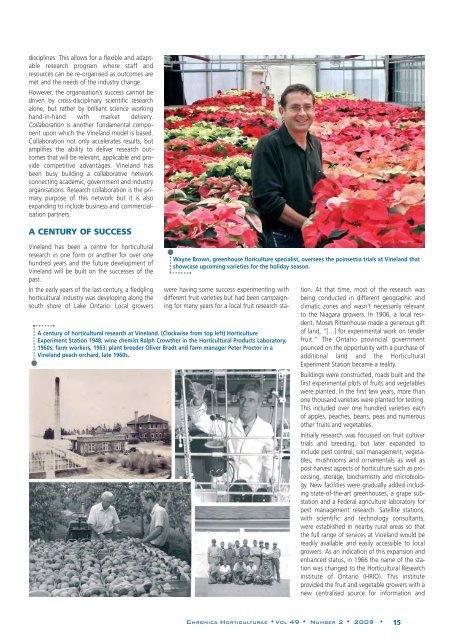Chronica Horticulturae volume 49 number 2 ... - Acta Horticulturae
Chronica Horticulturae volume 49 number 2 ... - Acta Horticulturae
Chronica Horticulturae volume 49 number 2 ... - Acta Horticulturae
Create successful ePaper yourself
Turn your PDF publications into a flip-book with our unique Google optimized e-Paper software.
disciplines. This allows for a flexible and adaptable<br />
research program where staff and<br />
resources can be re-organised as outcomes are<br />
met and the needs of the industry change.<br />
However, the organisation’s success cannot be<br />
driven by cross-disciplinary scientific research<br />
alone, but rather by brilliant science working<br />
hand-in-hand with market delivery.<br />
Collaboration is another fundamental component<br />
upon which the Vineland model is based.<br />
Collaboration not only accelerates results, but<br />
amplifies the ability to deliver research outcomes<br />
that will be relevant, applicable and provide<br />
competitive advantages. Vineland has<br />
been busy building a collaborative network<br />
connecting academic, government and industry<br />
organisations. Research collaboration is the primary<br />
purpose of this network but it is also<br />
expanding to include business and commercialisation<br />
partners.<br />
A CENTURY OF SUCCESS<br />
Vineland has been a centre for horticultural<br />
research in one form or another for over one<br />
hundred years and the future development of<br />
Vineland will be built on the successes of the<br />
past.<br />
In the early years of the last century, a fledgling<br />
horticultural industry was developing along the<br />
south shore of Lake Ontario. Local growers<br />
A century of horticultural research at Vineland. (Clockwise from top left) Horticulture<br />
Experiment Station 1948; wine chemist Ralph Crowther in the Horticultural Products Laboratory,<br />
1960s; farm workers, 1963; plant breeder Oliver Bradt and farm manager Peter Proctor in a<br />
Vineland peach orchard, late 1960s.<br />
Wayne Brown, greenhouse floriculture specialist, oversees the poinsettia trials at Vineland that<br />
showcase upcoming varieties for the holiday season.<br />
were having some success experimenting with<br />
different fruit varieties but had been campaigning<br />
for many years for a local fruit research station.<br />
At that time, most of the research was<br />
being conducted in different geographic and<br />
climatic zones and wasn’t necessarily relevant<br />
to the Niagara growers. In 1906, a local resident,<br />
Moses Rittenhouse made a generous gift<br />
of land, “[…] for experimental work on tender<br />
fruit.” The Ontario provincial government<br />
pounced on the opportunity with a purchase of<br />
additional land and the Horticultural<br />
Experiment Station became a reality.<br />
Buildings were constructed, roads built and the<br />
first experimental plots of fruits and vegetables<br />
were planted. In the first few years, more than<br />
one thousand varieties were planted for testing.<br />
This included over one hundred varieties each<br />
of apples, peaches, beans, peas and numerous<br />
other fruits and vegetables.<br />
Initially research was focussed on fruit cultivar<br />
trials and breeding, but later expanded to<br />
include pest control, soil management, vegetables,<br />
mushrooms and ornamentals as well as<br />
post harvest aspects of horticulture such as processing,<br />
storage, biochemistry and microbiology.<br />
New facilities were gradually added including<br />
state-of-the-art greenhouses, a grape substation<br />
and a Federal agriculture laboratory for<br />
pest management research. Satellite stations,<br />
with scientific and technology consultants,<br />
were established in nearby rural areas so that<br />
the full range of services at Vineland would be<br />
readily available and easily accessible to local<br />
growers. As an indication of this expansion and<br />
enhanced status, in 1966 the name of the station<br />
was changed to the Horticultural Research<br />
Institute of Ontario (HRIO). This institute<br />
provided the fruit and vegetable growers with a<br />
new centralised source for information and<br />
CHRONICA HORTICULTURAE •VOL <strong>49</strong> • NUMBER 2 • 2009 • 15
















